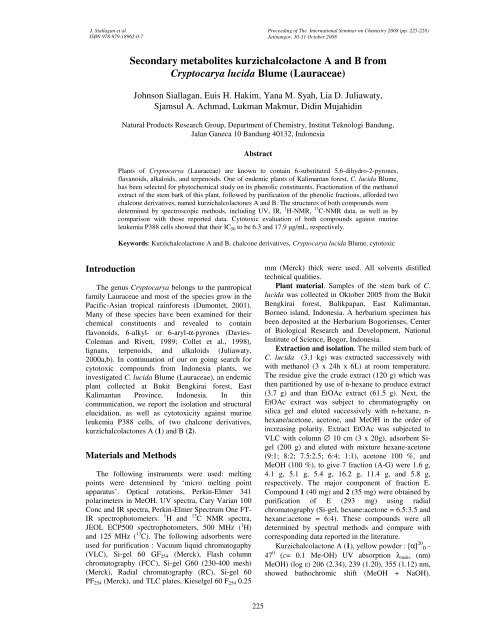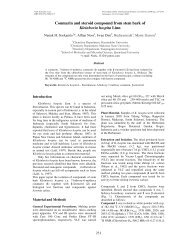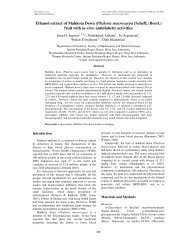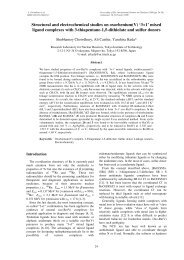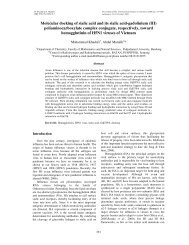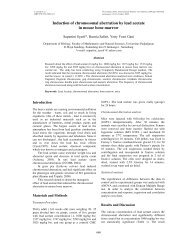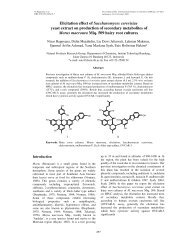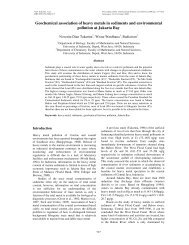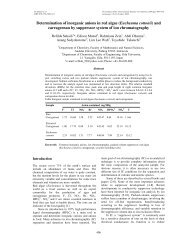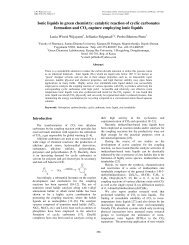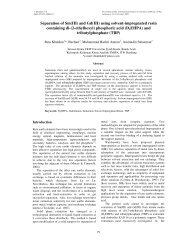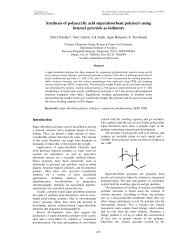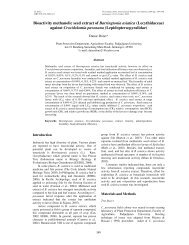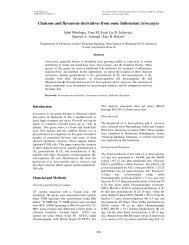Secondary metabolites kurzichalcolactone A and B from ...
Secondary metabolites kurzichalcolactone A and B from ...
Secondary metabolites kurzichalcolactone A and B from ...
You also want an ePaper? Increase the reach of your titles
YUMPU automatically turns print PDFs into web optimized ePapers that Google loves.
J. Siallagan et al.<br />
ISBN 978-979-18962-0-7<br />
Introduction<br />
225<br />
Proceeding of The International Seminar on Chemistry 2008 (pp. 225-228)<br />
Jatinangor, 30-31 October 2008<br />
<strong>Secondary</strong> <strong>metabolites</strong> <strong>kurzichalcolactone</strong> A <strong>and</strong> B <strong>from</strong><br />
Cryptocarya lucida Blume (Lauraceae)<br />
Johnson Siallagan, Euis H. Hakim, Yana M. Syah, Lia D. Juliawaty,<br />
Sjamsul A. Achmad, Lukman Makmur, Didin Mujahidin<br />
Natural Products Research Group, Department of Chemistry, Institut Teknologi B<strong>and</strong>ung,<br />
Jalan Ganeca 10 B<strong>and</strong>ung 40132, Indonesia<br />
Abstract<br />
Plants of Cryptocarya (Lauraceae) are known to contain 6-substituted 5,6-dihydro-2-pyrones,<br />
flavanoids, alkaloids, <strong>and</strong> terpenoids. One of endemic plants of Kalimantan forest, C. lucida Blume,<br />
has been selected for phytochemical study on its phenolic constituents. Fractionation of the methanol<br />
extract of the stem bark of this plant, followed by purification of the phenolic fractions, afforded two<br />
chalcone derivatives, named <strong>kurzichalcolactone</strong>s A <strong>and</strong> B. The structures of both compounds were<br />
determined by spectroscopic methods, including UV, IR, 1 H-NMR, 13 C-NMR data, as well as by<br />
comparison with those reported data. Cytotoxic evaluation of both compounds against murine<br />
leukemia P388 cells showed that their IC 50 to be 6.3 <strong>and</strong> 17.9 µg/mL, respectively.<br />
Keywords: Kurzichalcolactone A <strong>and</strong> B, chalcone derivatives, Cryptocarya lucida Blume, cytotoxic<br />
The genus Cryptocarya belongs to the pantropical<br />
family Lauraceae <strong>and</strong> most of the species grow in the<br />
Pacific-Asian tropical rainforests (Dumontet, 2001).<br />
Many of these species have been examined for their<br />
chemical constituents <strong>and</strong> revealed to contain<br />
flavonoids, 6-alkyl- or 6-aryl-α-pyrones (Davies-<br />
Coleman <strong>and</strong> Rivett, 1989; Collet et al., 1998),<br />
lignans, terpenoids, <strong>and</strong> alkaloids (Juliawaty,<br />
2000a,b). In continuation of our on going search for<br />
cytotoxic compounds <strong>from</strong> Indonesia plants, we<br />
investigated C. lucida Blume (Lauraceae), an endemic<br />
plant collected at Bukit Bengkirai forest, East<br />
Kalimantan Province, Indonesia. In this<br />
communication, we report the isolation <strong>and</strong> structural<br />
elucidation, as well as cytotoxicity against murine<br />
leukemia P388 cells, of two chalcone derivatives,<br />
<strong>kurzichalcolactone</strong>s A (1) <strong>and</strong> B (2).<br />
Materials <strong>and</strong> Methods<br />
The following instruments were used: melting<br />
points were determined by ‘micro melting point<br />
apparatus’. Optical rotations, Perkin-Elmer 341<br />
polarimeters in MeOH. UV spectra, Cary Varian 100<br />
Conc <strong>and</strong> IR spectra, Perkin-Elmer Spectrum One FT-<br />
IR spectrophotometers. 1 H <strong>and</strong> 13 C NMR spectra,<br />
JEOL ECP500 spectrophotometers, 500 MHz ( 1 H)<br />
<strong>and</strong> 125 MHz ( 13 C). The following adsorbents were<br />
used for purification : Vacuum liquid chromatogaphy<br />
(VLC), Si-gel 60 GF254 (Merck), Flash column<br />
chromatography (FCC), Si-gel G60 (230-400 mesh)<br />
(Merck), Radial chromatography (RC), Si-gel 60<br />
PF254 (Merck), <strong>and</strong> TLC plates, Kieselgel 60 F254 0.25<br />
mm (Merck) thick were used. All solvents distilled<br />
technical qualities.<br />
Plant material. Samples of the stem bark of C.<br />
lucida was collected in Oktober 2005 <strong>from</strong> the Bukit<br />
Bengkirai forest, Balikpapan, East Kalimantan,<br />
Borneo isl<strong>and</strong>, Indonesia. A herbarium specimen has<br />
been deposited at the Herbarium Bogorienses, Center<br />
of Biological Research <strong>and</strong> Development, National<br />
Institute of Science, Bogor, Indonesia.<br />
Extraction <strong>and</strong> isolation. The milled stem bark of<br />
C. lucida (3.1 kg) was extracted successively with<br />
with methanol (3 x 24h x 6L) at room temperature.<br />
The residue give the crude extract (120 g) which was<br />
then partitioned by use of n-hexane to produce extract<br />
(3.7 g) <strong>and</strong> than EtOAc extract (61.5 g). Next, the<br />
EtOAc extract was subject to chromatography on<br />
silica gel <strong>and</strong> eluted successively with n-hexane, nhexane/acetone,<br />
acetone, <strong>and</strong> MeOH in the order of<br />
increasing polarity. Extract EtOAc was subjected to<br />
VLC with column ∅ 10 cm (3 x 20g), adsorbent Sigel<br />
(200 g) <strong>and</strong> eluted with mixture hexane-acetone<br />
(9:1; 8:2; 7.5:2.5; 6:4; 1:1), acetone 100 %, <strong>and</strong><br />
MeOH (100 %), to give 7 fraction (A-G) were 1.6 g,<br />
4.1 g, 5.1 g, 5.4 g, 16.2 g, 11.4 g, <strong>and</strong> 5.8 g,<br />
respectively. The major component of fraction E.<br />
Compound 1 (40 mg) <strong>and</strong> 2 (35 mg) were obtained by<br />
purification of E (293 mg) using radial<br />
chromatography (Si-gel, hexane:acetone = 6.5:3.5 <strong>and</strong><br />
hexane:acetone = 6:4). These compounds were all<br />
determined by spectral methods <strong>and</strong> compare with<br />
corresponding data reported in the literature.<br />
Kurzichalcolactone A (1), yellow powder : [α] 20 D -<br />
47 0 (c= 0.1 Me-OH) UV absorption λmaks (nm)<br />
MeOH) (log ε) 206 (2.34), 239 (1.20), 355 (1.12) nm,<br />
showed bathochromic shift (MeOH + NaOH).
J. Siallagan et al.<br />
number Compound 1(lit.)<br />
2<br />
3<br />
4<br />
5<br />
6<br />
7<br />
8<br />
9<br />
10<br />
11<br />
12<br />
13<br />
14<br />
15<br />
16<br />
17<br />
18<br />
19<br />
20<br />
21<br />
22<br />
23<br />
24<br />
25<br />
26<br />
27<br />
1’<br />
2’<br />
3’<br />
4’<br />
5’<br />
6’<br />
OH-5<br />
δC δH<br />
226<br />
Proceeding of The International Seminar on Chemistry 2008 (pp. 225-228)<br />
Jatinangor, 30-31 October 2008<br />
Table 1 NMR Data for Kurzichalcolactones A (1) <strong>and</strong> B (2) in (acetone-d6)<br />
143.3 7.72 d (16)<br />
128.9 8.22 d (16)<br />
193.4<br />
162.6<br />
97.0 6.11 s<br />
167.4<br />
105.5<br />
159.6<br />
106.2<br />
175.1<br />
34.6 2.22 tl (7)<br />
22.1 1.50-1.80 m<br />
36.1 1.50-1.80 m<br />
71.4 3.78 m<br />
36.5 1.50-1.80 m<br />
24.5 3.58 dd (3; 2.5)<br />
34.4 2.12 dd (13; 2.5)<br />
2.20 dd (13; 3)<br />
100<br />
132.4 7.12 d (16)<br />
131.0 6.68 d (16)<br />
137.5<br />
128.3 7.53 m<br />
129.5 7.36 m<br />
129.5 7.36 m<br />
129.5 7.36 m<br />
128.3 7.53 m<br />
136.7<br />
130.0 7.62 m<br />
130.0 7.46 m<br />
130.0 7.46 m<br />
130.0 7.46 m<br />
130.0 7.62 m<br />
14.10 s<br />
Compound 2(lit.)<br />
δC δH<br />
143.1 7.72 d (15.6)<br />
128.6 8.31 d (15.6)<br />
193.8<br />
163.5<br />
94.9 6.09 s<br />
164.5<br />
106.2<br />
161.0<br />
106.1<br />
174.7<br />
34.7 2.30 tl (7.0)<br />
23.9 1.50-1.80 m<br />
35.9 1.50-1.80 m<br />
71.0 3.70 m<br />
36.1 1.50-1.80 m<br />
21.9 3.55 m<br />
34.2 2.17 dd (12.9; 2.7)<br />
1.91 dd (12.9; 3.1)<br />
99.4<br />
131.4 6.94 d (16.1)<br />
131.2 6.42 d (16.1)<br />
137.3<br />
127.8 7.54 dl<br />
129.3 7.37 tl (7.5)<br />
129.0 7.29 tl (7.5)<br />
129.3 7.37 tl (7.5)<br />
127.8 7.54 m<br />
136.6<br />
129.6 7.71 m<br />
130.0 7.46 m<br />
130.9 7.46 m<br />
130.0 7.46 m<br />
129.6 7.71 m<br />
14.50 s<br />
Compound 1 (isolated)<br />
δC δH<br />
142.6 7.71 d (15.9)<br />
128.6 8.19 d (15.9)<br />
193.0<br />
159.5<br />
96.5 6.09 s<br />
166.7<br />
105.0<br />
162.0<br />
105.7<br />
173.1<br />
34.1 2.04 m<br />
21.7 1.50-1.60 m<br />
35.6 1.60-1.70 m<br />
70.9 3.78 m<br />
36.1 1.70-1.80 m<br />
24.1 3.57 m<br />
33.9 2.17 dd (13; 2.5)<br />
2.29 dd (13; 2.5)<br />
99.6<br />
131.9 7.09 d (16)<br />
130.6 6.66 d (16)<br />
137.0<br />
127.8 7.51 m<br />
129.0 7.34 m<br />
129.0 7.34 m<br />
129.0 7.34 m<br />
127.8 7.51 m<br />
136.2<br />
130.5 7.54 m<br />
129.6 7.38 m<br />
129.6 7.38 m<br />
129.6 7.38 m<br />
130.0 7.54 m<br />
14.13 s<br />
Compound 2<br />
(isolated) δH<br />
7.81 d (15.9)<br />
8.29 d (15.9)<br />
6.07 s<br />
2.22 tl (7)<br />
1.52-1.62 m<br />
1.69-1.76 m<br />
3.70 m<br />
1.89-1.91 m<br />
3.54 dd (3; 2.5)<br />
2.16 dd (12.8; 2.29)<br />
2.29 dd (12.8; 2.29)<br />
6.92 d (15.9)<br />
6.41 d (15.9)<br />
7.52 m<br />
7.35 m<br />
7.35 m<br />
7.35 m<br />
7.52 m<br />
7.70 m<br />
7.43 m<br />
7.43 m<br />
7.43 m<br />
7.70 m<br />
14.50 s<br />
Table 2 IC 50 values of some chalcolactone against murine leukemia P-388 cells<br />
Compounds Classes of compound IC50 (µg/mL)<br />
Kurzichalcolactone A (1)<br />
Kurzichalcolactone B (2)<br />
Artonin E<br />
Chalcolactone<br />
Chalcolactone<br />
3-prenylflavone<br />
a For significant activity, an IC50 < 4.0 µg/mL is required.<br />
b Positive control<br />
IR b<strong>and</strong>s spectrum (KBr) V maks (cm -1 ), 3171 cm -1 (br,<br />
OH), 2938 cm -1 (CH-aliphatic), 1707, 1626, cm -1<br />
(lactone, C=O conjugated systems), 1344, 1227, 1158,<br />
1082, 1032, 975, 940, 749, <strong>and</strong> 692 cm -1 . 1 H NMR<br />
(500 MHz, acetone-d6): 8.19 (1H, d, J= 15.9), 7.71<br />
(1H, d, J= 15.9), 7.54 (2H, m), 7.51 (2H, m), 7.38<br />
(3H, m), 7.34 (3H, m), 7.09 (1H, d, J= 16), 6.66 (1H,<br />
d, J= 16), 6.09 (1H, s), 3.78 (1H, m), 3.70 (1H, m),<br />
2.29 (1H, dd, J= 13; J= 3), 2.17 (1H, dd, J= 13; J=<br />
6.3<br />
17.9<br />
0.6<br />
2.5), 2.04 (1H, m), 1.70-1.80 (1H, m), 1.60-1.70 (1H,<br />
m), 1.50-1.60 (1H, m), 14.13 (1 OH). 13 C NMR see<br />
Table 1.<br />
Kurzichalcolactone B (2) yellow powder : [α] 20 D -<br />
88 0 (c= 0.1 Me-OH) UV absorption λmaks (nm)<br />
MeOH) (log ε) 205 (1.28), 236 (0.61), 254 (0.55),<br />
344 (0.74) nm, showed bathochromic shift (MeOH +<br />
NaOH). IR b<strong>and</strong>s spectrum (KBr) V maks (cm -1 ) 3224<br />
cm -1 (br, OH), 2937 cm -1 (CH-aliphatic), 1706, 1626,
J. Siallagan et al.<br />
cm -1 (lactone, C=O conjugated systems), 1338, 1227,<br />
1139, 1084, 970, 933, 749, <strong>and</strong> 691 cm -1 . 1 H NMR<br />
(500 MHz, acetone-d6): 8.29 (1H, d, J= 15.9), 7.81<br />
(1H, d, J= 15.9), 7.70 (2H, m), 7.52 (2H, m), 7.43<br />
(3H, m), 7.35 (3H, m), 6.92 (1H, d, J= 15.9), 6.41<br />
(1H, d, J= 15.9), 6.07 (1H, s), 3.70 (1H, m), 3.54 (1H,<br />
dd, J= 3; 2.5), 2.29 (1H, dd J= 12.8; 2.29), 2.22 tl (7),<br />
2.16 (1H, dd, J= 12.8; J= 2.9), 2.04 (1H, m), 1.89-<br />
1.91 (1H, m), 1.69-1.76 (1H, m), 1.60-1.70 (1H, m),<br />
1.52-1.62 (1H, m), 14.50 (1 OH).<br />
Results <strong>and</strong> Discussion<br />
The dried milled stem bark of C. lucida was<br />
macerated with methanol, <strong>and</strong> the methanol extract<br />
was partitioned into n-hexane <strong>and</strong> EtOAc,<br />
respectively. The EtOAc fraction was refractionated<br />
by VLC on silica gel, <strong>and</strong> the fraction contain of<br />
phenolic compounds was purified by radial<br />
chromatography on silica gel to give<br />
<strong>kurzichalcolactone</strong>s A (1) <strong>and</strong> B (2).<br />
Compound 1 showed IR absorption maxima at<br />
3171, 1707, <strong>and</strong> 1626 cm -1 , indicated the presence of<br />
hydroxyl, lactone, <strong>and</strong> conjugated ketone<br />
functionalities. A comparison of the NMR spectra of 1<br />
with those of <strong>kurzichalcolactone</strong> B (2), isolated <strong>from</strong><br />
this plant <strong>and</strong> previously <strong>from</strong> C. kurzii <strong>and</strong> C.<br />
obovata revealed the strong structural similarity of<br />
these two compounds (Table 1) <strong>and</strong> indicated that<br />
compound 1 was a stereoisomer of 2. Analysis of the<br />
1 H- 1 H COSY, HMQC, <strong>and</strong> HMBC spectra permitted<br />
the assignment of all proton <strong>and</strong> carbon signals for 1.<br />
There are three asymmetric carbons in compounds 1<br />
<strong>and</strong> 2, at the 15, 17, <strong>and</strong> 19 positions. The signals for<br />
H-15 <strong>and</strong> H-17 in the 1 H NMR spectrum of both 1 <strong>and</strong><br />
2 are essentially identical, suggesting that the two<br />
isomers possess the same configuration at these<br />
positions <strong>and</strong> only differ by the α or β position at the<br />
C-19 position. Moreover, the small coupling constants<br />
observed for H-17 in compounds 1 <strong>and</strong> 2 indicated an<br />
equatorial position for H-17 in both compounds,<br />
whereas the H-15 peak appearance.<br />
Kurzichalcolactones A (1) <strong>and</strong> B (2) had been<br />
previously isolated <strong>from</strong> leaves C. kurzii (Fu, 1993)<br />
<strong>and</strong> C. obovata (Dumontet, 2004), respectively.<br />
Biogenetically, 1 could be formed by a coupling of<br />
5,7,9-trihydroxychalcone with a tetraketide derivative<br />
of cinnamoyl to form kurzilactone, which is also<br />
isolated <strong>from</strong> C. Kurzii. Phenol coupling of this<br />
lactone would lead to a linear intermediate, which<br />
would cyclize twice to form the C8-C17 bond as well<br />
as the pyran ring.<br />
227<br />
Proceeding of The International Seminar on Chemistry 2008 (pp. 225-228)<br />
Jatinangor, 30-31 October 2008<br />
O<br />
O<br />
O OH 20<br />
OH<br />
19<br />
18<br />
OH<br />
O<br />
<strong>kurzichalcolactone</strong> A (1) : 19α- or 19β-OH<br />
<strong>kurzichalcolactone</strong> B (2): 19β- or 19α-OH<br />
Interesting biological activities have been<br />
described for many individual chalcone <strong>metabolites</strong><br />
isolated <strong>from</strong> Cryptocarya. In a preliminary bioassays,<br />
the fruit <strong>and</strong> trunk bark extracts of C. obovata showed<br />
56% <strong>and</strong> 23% inhibition at 10 µg/mL the ethanolic<br />
extracts against human nasopharyngeal KB cells<br />
(Dumontet, 2004).<br />
In further study, <strong>kurzichalcolactone</strong> A (1)<br />
exhibited weak cytotoxicity against the same cells<br />
with IC50 value of 15 µg/ml (Fu, 1993). In our study,<br />
we evaluated cytotoxic properties of compounds 1 <strong>and</strong><br />
2 against murine leukemia P-388 cells (Table. 2)<br />
using MTT-assay method, with artonin E was used as<br />
positive control. As shown in Table 2, compound 1<br />
was more cytotoxic than compound 2. Thus, different<br />
stereochemical arrangement could have a different<br />
cytotoxic properties.<br />
Conclusions<br />
Two chalcolactones, i.e. <strong>kurzichalcolactone</strong>s A (1)<br />
<strong>and</strong> B (2) have been isolated <strong>from</strong> the methanol<br />
extract of the stem bark of C. lucida. The structures of<br />
these compounds were determined based on spectral<br />
analysis <strong>and</strong> by comparison with those reported data.<br />
The cytotoxic activities of both compounds were<br />
evaluated against murine leukaemia P388 cells <strong>and</strong><br />
showed their IC 50 values were 6.3 <strong>and</strong> 17.9 µg/ml,<br />
respectively.<br />
Acknowledgements<br />
We would like to thank the Dinas P dan P<br />
PEMDA Papua <strong>and</strong> Rector of Cenderawasih<br />
University Jayapura for the financial support, <strong>and</strong> Dr.<br />
Jalifah Latip <strong>from</strong> UKM for measurements for<br />
spectral data. We also very thankful for the Herbarium<br />
Bogoriense staffs, Bogor, for the identification of the<br />
sample.
J. Siallagan et al.<br />
References<br />
Fu, X., sevenet, T., Remy, F., Pais, M., Hadi, A. H.A.,<br />
Zeng, L. M., (1993),”Flavanone <strong>and</strong> Chalcone<br />
Derivatives <strong>from</strong> Cryptocarya kuzii,” J. Nat.<br />
Prod., 56, 1153-63<br />
Dumontet, V., Hung, N. V., Adeline, M.T., Riche, C.,<br />
Chiaroni, A., Sevenet, T., <strong>and</strong> Gueritte, F.<br />
(2004),”Cytotoxic Flavonoids <strong>and</strong> a-Pyrones <strong>from</strong><br />
Cryptocarya obovata,” J. Nat. Prod, 67, 858-862<br />
Dumontet, V., Gaspard, C., Hung, N. V., Fahy, J.,<br />
Tchertanov, L., Sevenet, T., <strong>and</strong> Gueritte, F<br />
(2001),”New Cytotoxic Flavonoids <strong>from</strong><br />
Cryptocarya infectoria,” Tetrahedron 2001, 57,<br />
6189-6196.<br />
Davies-Coleman, M. T., <strong>and</strong> Rivett, D. E. A.,<br />
(1989),”Naturally Occuring 6-substituted 5,6dihyrdo-α-pyrones”,<br />
Progress in the Chemistry of<br />
Organic Natural Products, 55, 1-35<br />
Juliawaty, L. D., Achmad, S. A., Makmur, L., <strong>and</strong><br />
Hakim, E. H., (1993),”Taxonomy of Tropical<br />
Trees for Genetic Diversity Studies: Investigation<br />
of the Chemical Constituents of Cryptocarya<br />
laevigata Bl <strong>and</strong> C. nutans <strong>and</strong> its Relation to the<br />
Taxonomy of Lauraceae”, Biotrop Spec. publ, No<br />
51, 143-8<br />
Juliawaty, L. D., Kitajima, M., Takayama, H.,<br />
Achmad, S. A., <strong>and</strong> Aimi, N., (2000a),”A New<br />
Type of Stilbene – Related <strong>Secondary</strong> Metabolite<br />
Idenburgene <strong>from</strong> Cryptocarya idenburgensis”,<br />
Chem. Pharm. Bull, 48, 1726-8<br />
Juliawaty, L. D., Kitajima, M., Takayama, H.,<br />
Achmad, S. A., <strong>and</strong> Aimi, N., (2000b),”A 6substituted<br />
-5,6-dihydro-2-pyrone <strong>from</strong><br />
Cryptocarya strictifolia”, Phytochemistry, 54,<br />
989-93<br />
Juliawaty, L. D., Aimi, N., Ghisalberti, E. L.,<br />
Kitajima, M., Makmur, L., Syah, Y. M., Siallagan,<br />
J., Takayama, H., Achmad, S. A <strong>and</strong> Hakim., E.<br />
H., (2006).,”Chemistry of Indonesian Cryptocarya<br />
Plants”, Chemistry of Natural Products: Recent<br />
Trends & Developments, 399-423, ISBN: 81-<br />
228<br />
Proceeding of The International Seminar on Chemistry 2008 (pp. 225-228)<br />
Jatinangor, 30-31 October 2008<br />
0140X Editor: Goutam Brahmacari, Research<br />
Signpost, Triv<strong>and</strong>rum, Kerala-India.<br />
Lemmens, R. H. M. J., Soerianegara, I, <strong>and</strong> Wong, W.<br />
C., 1995,”Plant Resource of South-East Asia”, No<br />
5 (2) PROSEA, Bogor<br />
Rohmer, J. G., 1993 dalam: Kubitzki, K., Rohmer, J.<br />
G., <strong>and</strong> Bittrich, V.,”The Families <strong>and</strong> Genera of<br />
Vascular”, Vol 2. Flowering Plants, Dicotiledons:<br />
Magnoliid, Hamamelid, <strong>and</strong> Caryophyllid<br />
Families. Berlin: Springer Verlag, 366-91<br />
Saad, J. M., Soepadamo, E., Fang, S. P., McLaughlin,<br />
J. L., <strong>and</strong> Fanwick, P. E., (1991),”(-)-Gr<strong>and</strong>isin<br />
<strong>from</strong> Cryptocarya crassinervia,”, J. Nat. Prod”,<br />
54, 1681-3<br />
Collins, D. J., Culvenor, C. C. J., Lamberton, J. A.,<br />
Loder, J. W., <strong>and</strong> Price, J. R., (1990),”Plants for<br />
Medicine: A Chemical <strong>and</strong> Pharmacological<br />
survey of Plants in the Australian Region”,<br />
CSIRO, Melbourne, 20-109<br />
Gottlieb, O. R., (1972),”Chemosystematics of the<br />
Lauraceae”, Phytochemistry, 11, 1537-70<br />
Govindachari, T. R., <strong>and</strong> Parthasarathy, P. C.,<br />
(1972),”Cryptocaryone, A Novel 5’,6’dihydrochalcone,<br />
<strong>from</strong> Cryptocarya bourdilloni<br />
GAMB., Tetrahedron Lett., 33, 3419-20<br />
Govindachari, T. R., Parthasarathy, P. C., Desai,<br />
H.K., <strong>and</strong> Shannbhag, M. N., (1973),”Structure of<br />
Cryptocaryone, a constituent of Cryptocarya<br />
bourdillonii GAMB, Tetrahedron, 29, 3091-4<br />
Kosterman, A.J.G.H., (1957), Comm. Forestm Res.<br />
Inst. Indonesia, No.37<br />
Kosterman, A.J.G.H., (1964),Bibiliographia<br />
Lauracearum, Ministery of National Research,<br />
Bogor<br />
Kosterman, A. J. G. H., (1968), “Material for A<br />
Revision of Lauraceae I”, Reinwardt, Herbarium<br />
Bogoriense, Bogor, Indonesia<br />
Zschocke, S., dan Van Staden, J.,<br />
(2000),”Cryptocarya Spesies-Substitute Plants for<br />
Ocotea bullata? A Pharmacological Investigation<br />
Interm of Cyclooxygenase -1 <strong>and</strong> -2 inhibition”, J<br />
of Etnopharmacology, 71, 473-8


